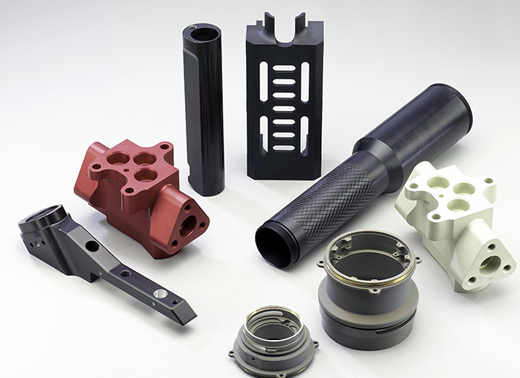| Anodizing

| Chromic Acid Anodize
Chromic acid anodizing or type I anodize results in the thinnest anodic coat of the principal three types; typically on the order of .00002”-.0001” (20 to 100 micro inches) per surface. While thin, when properly sealed chromic anodize affords the aluminium equal corrosion protection to the thicker sulphuric and hard coat type anodize. Chromic anodize appears much grayer in colour and being thinner absorbs less colour when dyed. This limits chromic acid anodize as a decorative finish, however, it can be dyed black for use as a non-reflective, protective coating on housings for optical components. Even black dyed chromic anodize is lighter in appearance (grayer), than conventional sulphuric black anodize. In order to get chromic anodize to accept black dye, the temperature of the chromic acid must be raised, therefore, it isn’t done every day and must be scheduled accordingly.
Chromic Acid Anodize
- Good for tight tolerance parts: will not change dimensions
- Can be black dyed – other colours not practical
- Good for Bonding
- Non-Conductive
- Good for welded parts and assemblies
Chromic Acid Anodize Applications:
- Precision Machined Components
- Aerospace Components
- Welded components and assemblies
- As a paint/prime base
| Boric-Sulfuric Acid Anodize (BSAA)
Boric-Sulphuric Acid Anodize (BSAA) is an alternative to chromic acid anodize (CAA) due to the environmental, worker safety and health concerns and the related costs associated with continued use of hexavalent chromium-bearing processes such as CAA. Primary applications include aircraft and aerospace components. It is covered by MIL-A-8625, Type I c and aerospace specifications including Boeing’s BAC 5632. It is used for corrosion protection and paint adhesion. Paint adhesion is equal or superior to chromic acid, and the process is more energy-efficient than chrome-based processes.
Boric-Sulphuric Acid Anodize Features:
- Good for tight tolerance parts: will not change dimensions
- Corrosion protection
- Good for Bonding
- Non-Conductive
Boric-Sulfuric Acid Anodize Applications:
Precision Machined Components
Aerospace/Aircraft Components
As a paint/prime base
| Sulfuric Acid Anodize
Sulphuric Acid Anodize Benefits:
- Less expensive than other types of Anodize with respect to chemicals used, heating, power consumption, and length of time to obtain required thickness.
- More alloys can be finished.
- Harder than chromic anodize.
- Clearer finish permits dying with a greater variety of colours.
- Waste Treatment is easier than chromic anodize, which also helps to reduce cost.
Sulfuric Acid Anodize Applications:
- Optical components
- Hydraulic valve bodies
- Military weapons
- Computer and electronic enclosures
- Mechanical hardware
| Hard Anodize (Hard Coat)
Hard coat anodize, while usually done in a sulphuric acid based electrolyte, is much thicker and denser than the more conventional sulphuric anodize. Hard coat is specified for aluminium components subject to extreme wear applications where superior abrasion resistance is needed or corrosive environments where a thicker, harder, more durable coating is necessary. It can also be valuable where enhanced electrical insulation is required. Since hard coat anodize can be built up to several thousands in some cases, it makes this type of anodize a candidate for salvaging worn or mis-machined components.
Hard Anodize Features:
- Improved wear resistance
- Non-conductive
- Can repair worn surfaces on aluminium
- Improve parts surface for slide applications
- Can be black dyed; other colours less decorative
- Finish is harder than tool steel
- Can be ground or lapped
Hard Anodize Applications:
- Valves
- Pistons
- Sliding Parts
- Hinge Mechanisms
- Cams
- Gears
- Swivel Joints
- Insulation Plates
- Blast Shields
